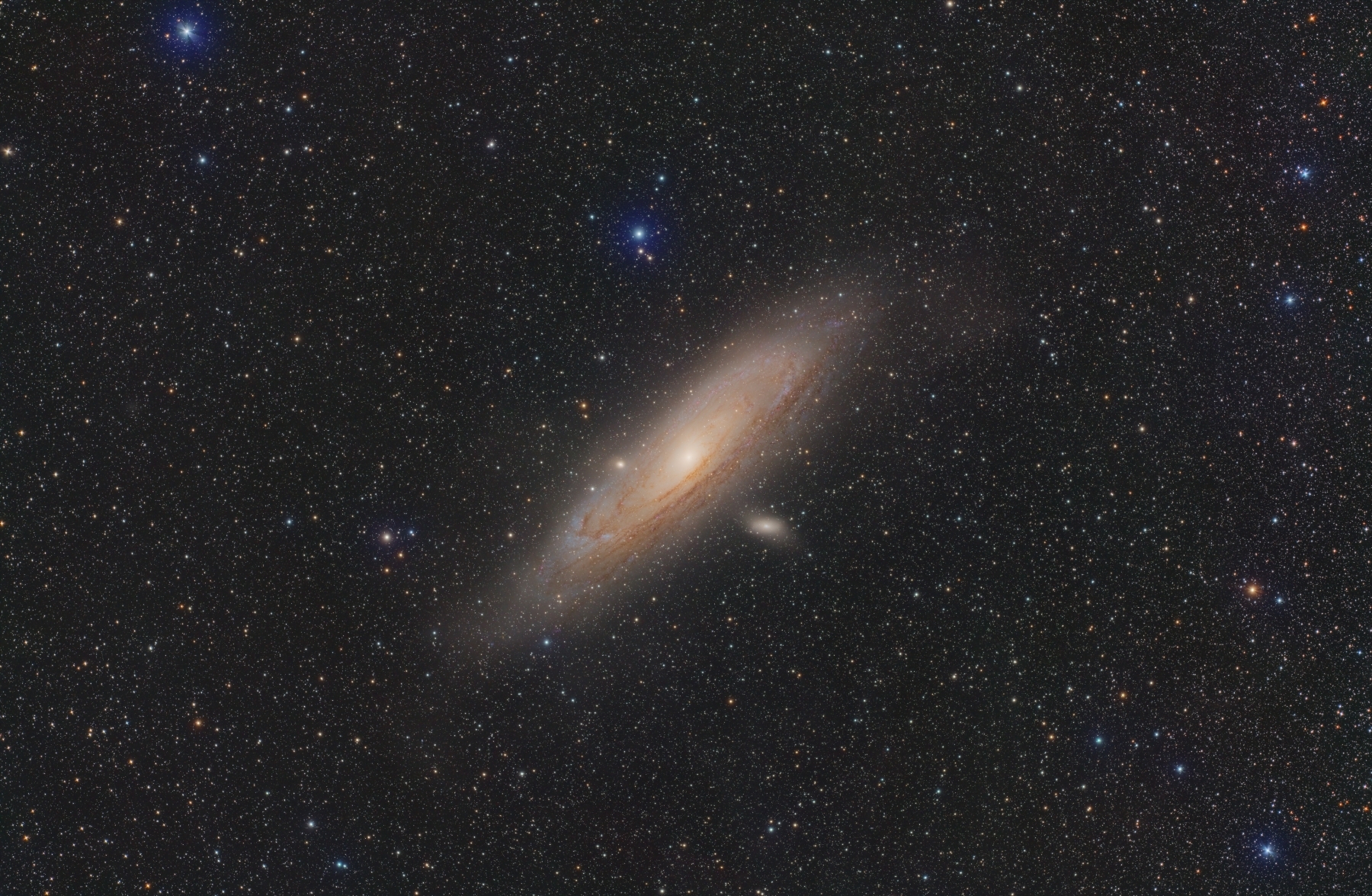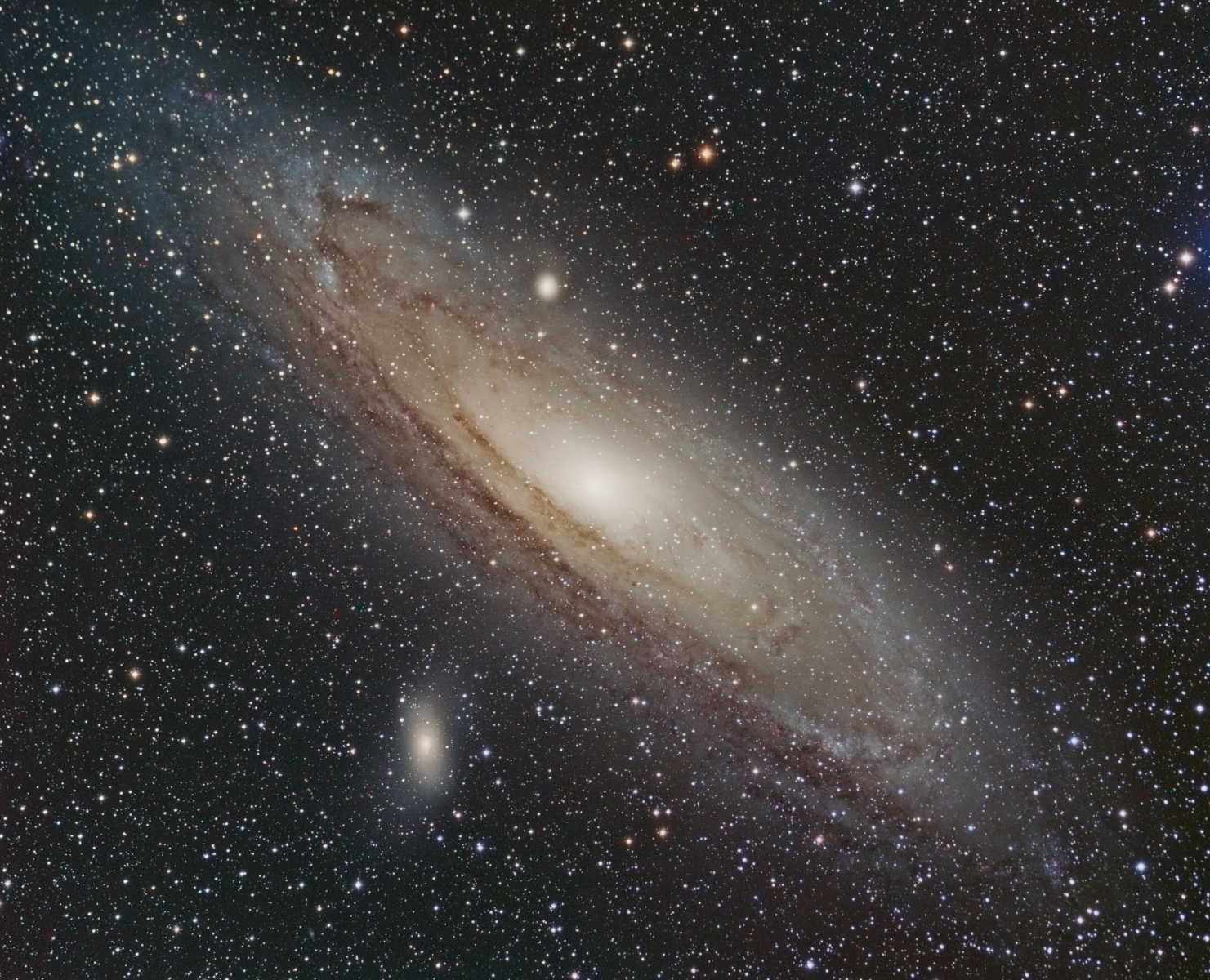The Andromeda Galaxy – M31
The Andromeda Galaxy, also known as M31 and NGC224, holds the distinction of being the largest galaxy within the Local Group. Positioned at a distance of approximately 2.5 million light-years from Earth, it stands as the nearest spiral galaxy to our own. Encompassing the galactic halo, it spans a vast distance of 220,000 light-years and boasts a mass equivalent to about one trillion solar masses. Its structure, characterized by a harmonious interplay of celestial elements, unveils the majestic presence of a spiral galaxy sharing the cosmic stage with our own galaxy – The Milky Way. The Andromeda Galaxy showcases a rich variety of stars, gas, and dust, forming a visually captivating spectacle. Notably, its apparent size in the night sky is comparable to the width of six full moons and can be observed unaided from a dark sky site.
At the core of Andromeda’s architectural splendor are its magnificent spiral arms, gracefully winding through the galaxy. These arms, adorned with youthful, luminous stars, create a breathtaking visual display. The intricate patterns delineated by dust lanes and stellar clusters within the arms contribute depth and character to the overall appearance of Andromeda.
M31 as seen through the Redcat 51
| Optics | RedCat51 - f/4.9 250 mm FL |
| Mount | Losmandy G11 with Ovision Worm |
| Camera | ZWO ASI 6200MM |
| Filters | Astronomik Deep Sky LRGB |
| Exposure | RGB = 245m-250m-405m Total: 15 hours |
| Location | Addington Highlands |
| Date | October 2022 |
| Software | Pixinsight |
Observing the Andromeda Galaxy through a telescope is a captivating and awe-inspiring experience. The initial focal point is a faint, elongated smudge of light against the cosmic darkness. The galactic core stands out prominently, featuring a slightly brighter central region amidst the encompassing spiral arms. While these arms may not exhibit the same distinctness as seen in photographs, they contribute to an overall impression reminiscent of a cosmic whirlpool. The sheer magnitude of the Andromeda Galaxy becomes evident as one scans across its expansive celestial canvas.
In terms of its classification based on visible spectrum observations, Andromeda is categorized as a SA(s)b type spiral galaxy in the de Vaucouleurs–Sandage extended classification system for spiral galaxies. This classification initially suggests an absence of a central bar. However, data acquired in the infrared spectrum reveals that, indeed, the galaxy possesses a central bar, similar to our own Milky Way Galaxy.
Star clusters can be seen in the Andromeda Galaxy in the following image. The fact that these clusters are 2.5 million light years away really says something about how far we have come technologically. That it is even possible to use a small refactor to capture this kind of detail is remarkable. Modern advancements in image sensors as well as telescope making is enabling high resolution images to be captured. Coupled with recent advancements in image processing we can see details of far off worlds our ancestors could never have dreamed of.
Wrapping up our journey, here’s an image captured in 2014 with a Takahashi FSQ106. For this particular shot, I utilized a .73x focal reducer to widen the field of view and enhance light-gathering capabilities. I’ve included this image to provide historical context, showcasing the level of my processing skills during that period.
M31 as seen through the FSQ106
| Optics | Takahashi FSQ106 with .73x reducer - f/3.65 387mm FL |
| Mount | Losmandy G11 with Ovision Worm |
| CCD | KAF-8300M based Camera |
| Filters | Astrodon LRGB E-Series Gen. 2 |
| Exposure | LRGB = 60-60-60-60 minutes Total: 4 hours |
| Location | North Frontenac Dark Sky Preserve |
| Date | August 2014 |
| Software | Pixinsight |
Locating the Andromeda Galaxy in the night sky
The Andromeda Galaxy has an apparent size equivalent to six full moons. While Andromeda is visible to the naked eye in dark skies, binoculars will enhance the view significantly. A telescope will reveal even more detail, and you may even spot M32 and M110, two companion galaxies to Andromeda.
Locating the Andromeda Galaxy (M31) using Cassiopeia as a guide can be an exciting journey. Follow these detailed steps to navigate the night sky and discover this cosmic marvel:
1. Find a Dark Sky Location: Select a location away from city lights and light pollution for optimal visibility. Dark skies enhance your chances of spotting celestial objects.
2. Identify Cassiopeia: Locate the prominent W-shaped constellation, Cassiopeia, in the northern sky. It is easily recognizable and serves as a useful guidepost.
3. Observe Cassiopeia’s Position: Take note of Cassiopeia’s position relative to the northern horizon. The W shape may appear tilted or upside-down depending on the time of the night and the season.
4. Use Cassiopeia’s Pointing Arm: Extend an imaginary line from the top of Cassiopeia’s W towards the northeast. Follow the direction of this pointing arm.
5. Locate Mirach in Andromeda: As you follow the line from Cassiopeia, you’ll encounter a bright star named Mirach. This star is part of the Andromeda constellation.
6. Move from Mirach to Mu Andromedae: From Mirach, backtrack a little toward Cassiopeia until you reach another star in Andromeda called Mu Andromedae. This star is on the path leading to the Andromeda Galaxy.
7. Find the Andromeda Galaxy: Continue along the same trajectory past Mu Andromedae, and you’ll come across a faint, elongated patch of light. This hazy oval is the Andromeda Galaxy!


